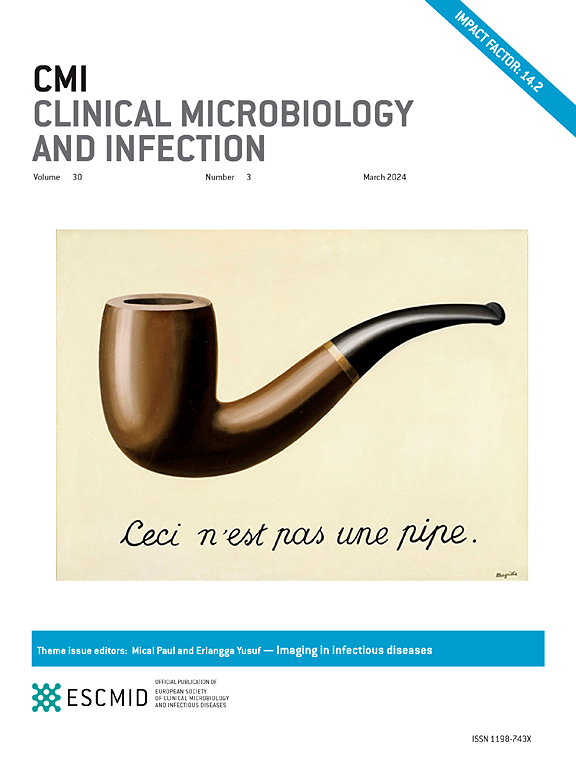Impact of Pseudomonas aeruginosa carriage on intensive care unit-acquired pneumonia: a European multicentre prospective cohort study
IF 10.9
1区 医学
Q1 INFECTIOUS DISEASES
引用次数: 0
Abstract
Objectives
Pseudomonas aeruginosa (PA) is a common causative pathogen of pneumonia acquired in the intensive care unit (ICU). The aim of this study was to determine the incidence of PA ICU pneumonia (PAIP) and to quantify its independent association with PA colonization at different body sites.
Methods
Adult patients on mechanical ventilation at ICU admission were prospectively enrolled across 30 European ICUs. PA colonization in the perianal area and in the lower respiratory tract was assessed within 72 hours after ICU admission and twice weekly until ICU discharge. PAIP development was evaluated daily. Competing risk models with colonization as a time-varying exposure and ICU death and discharge as competing events were fitted and adjusted for confounders to investigate the association between PA carriage and PAIP.
Results
A total of 1971 subjects were enrolled. The colonization prevalence with PA in the first 72 hours of ICU admission was 10.4% (179 perianal and 51 respiratory), whereas the acquisition incidence during the ICU stay was 7.0% (158 perianal and 47 respiratory). Of the 43 (1.8%) patients who developed PAIP, 11 (25.6%) were PA colonized on admission and 9 (20.9%) acquired colonization before PAIP onset. Both perianal (adjusted subdistribution hazard ratio, 4.4; 95% CI, 1.7–11.6) and respiratory colonization (adjusted subdistribution hazard ratio: 4.6, 95% CI, 1.9–11.1) were independently associated with PAIP development.
Discussion
PAIP incidence was higher in PA colonized vs. non-colonized patients. Colonization of both the rectum and of the respiratory tract was associated with development of PAIP. The increased risk of PA colonization for subsequent infection provides an opportunity for targeted preventive interventions.
铜绿假单胞菌携带对重症监护病房获得性肺炎的影响:一项欧洲多中心前瞻性队列研究。
目的:铜绿假单胞菌(PA)是重症监护病房肺炎的常见致病菌。本研究旨在确定 PA ICU 肺炎(PAIP)的发病率,并量化其与 PA 在不同身体部位定植的独立关联:方法:在欧洲 30 家重症监护病房对入院时接受机械通气的成人患者进行了前瞻性登记。在入住重症监护病房后 72 小时内对肛周和下呼吸道的 PA 定植情况进行评估,并每周评估两次,直至重症监护病房出院。每天评估 PAIP 的发展情况。将定植作为时变暴露,ICU死亡和出院作为竞合事件,拟合并调整混杂因素的竞合风险模型,以研究PA携带与PAIP之间的关联:结果:共招募了 1971 名受试者。入ICU后72小时内铜绿假单胞菌定植率为10.4%(179例肛周感染,51例呼吸道感染),ICU住院期间铜绿假单胞菌感染率为7.0%(158例肛周感染,47例呼吸道感染)。在 43 名(1.8%)发生 PAIP 的患者中,11 名(25.6%)在入院时已感染 PA,9 名(20.9%)在 PAIP 发病前已感染。肛周(调整后次分布危险比 [aSHR] 4.4,95%CI 1.7-11.6)和呼吸道定植(aSHR 4.6,95%CI 1.9-11.1)均与 PAIP 的发生独立相关:结论:PA定植患者与非定植患者的PAIP发病率更高。直肠和呼吸道的定植均与 PAIP 的发生有关。铜绿假单胞菌定植导致后续感染的风险增加,为有针对性的预防干预提供了机会。
本文章由计算机程序翻译,如有差异,请以英文原文为准。
求助全文
约1分钟内获得全文
求助全文
来源期刊
CiteScore
25.30
自引率
2.10%
发文量
441
审稿时长
2-4 weeks
期刊介绍:
Clinical Microbiology and Infection (CMI) is a monthly journal published by the European Society of Clinical Microbiology and Infectious Diseases. It focuses on peer-reviewed papers covering basic and applied research in microbiology, infectious diseases, virology, parasitology, immunology, and epidemiology as they relate to therapy and diagnostics.

 求助内容:
求助内容: 应助结果提醒方式:
应助结果提醒方式:


